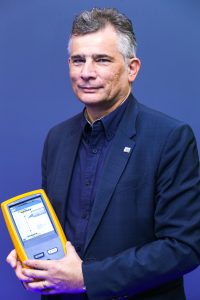Are copper networks going to disappear?
I have had discussions with people in the industry who say copper is going to disappear. What we see in the market is that with the advent of IoT, devices need to be connected to the Internet, and they need to be powered, which means copper is not going to go away anytime soon. However, there are different challenges around testing PoE, where everything from CCVT camera, access control systems to lightning systems are getting powered by the same cable that carries data.
In the past, we just tested data transmission against Cat6 or Cat6 A, but now there many new ways to check if a cable is qualified for PoE by testing many characteristics such as resistance unbalance, MPTL standards, and temperature. There are many more requirements when testing PoE systems that can be challenging, but these are new opportunities for us.
We see a lot of data centres being deployed, and mega cloud service providers such as Microsoft and AWS have set up local data centres to meet data and privacy regulations. All the fiber and copper installations in these facilities need to be tested and certified, and when something goes wrong, they need to be troubleshot, which is where we come in.
Another new area for us is industrial Ethernet, where the testing requirements are different, and of course, players are also different with names such as ABB and Siemens. Though Ethernet is at the transmission layer, on the connection side, instead of RJ45, you have M12. Our same testers can connect to industrial environments, but testing requirements would be different. Unlike Cat 6 or 6A cables, you have to measure things such as electromagnetic interference, latency issues, and temperature.
Are you showcasing any new products at Gitex?
Yes, we are showcasing a new solution related to data centres, which use MPO cassettes. This plug-and-play cassette is a pre-terminated modular system where instead of laying multiple fibers together, you bundle all the fibres together in a single jacket, and only at the end, you have a connector, which splits fibre optic light into several parts. It can be difficult to inspect MPO connectors, so what we offer is a special camera that automatically takes pictures of all the fibres inside these connectors, visualise it and certify it against the standards. This is our Fiberinspector product, which provides a graphical indication of problems that arise due to contamination, pits, chips, and scratches.
We are also showcasing our MicroScanner PoE device with new functionalities, which is dedicated to Power over Ethernet. When you have to connect a phone or camera to PoE, each device has a different class of power requirements. This device can help to measure the input power needed for your powered device and if the class of power offered by the switch is less than the powered device requires.










Discussion about this post